Data Analysis
Introduction
The previous chapter provided a detailed explanation of the method that would be used to collect and analyze primary data. In this chapter, the researcher focused on the actual analysis of data collected from different participants. Enterprise resource planning is gaining popularity in both developed and developing economies around the world. The need for different departments to share data in real-time has made it necessary for firms to embrace emerging technologies that can integrate their information system. In the review of the literature, it was established that many large companies are using the ERP to ensure that there is close interdepartmental and intradepartmental communication to enhance smooth operations. The software not only helps in planning the resources but also in making decisions in a way that the interests of all stakeholders are protected. In this chapter, the primary data collected from the sampled participants would help in confirming or refuting information gathered from secondary sources.
The researcher made sure that the participants sampled for the study were a representation of the entire population. The researcher was able to recruit three people in senior management positions. They included the branch manager and two assistant managers at the institution that participated in the data collection. One auditor has been relying on enterprise resource planning to facilitate his activities at the firm. Several supervisors, sales officers, and cashiers participated in the data collection process. One participant was an electrician. The branch manager is a holder of a Master’s degree in business management, while the auditor holds a bachelor’s degree in accounting. A significant number of the participants were holders of diplomas in different fields, while the rest were senior high school graduates. It was noted that all the participants were Ghanaians. The researcher was able to establish that the majority of respondents had been working with the company for over 4 years.
Data Analysis
When analyzing primary data, Bell, Bryman, and Harley (2018) explain that one should select an appropriate method that would help organize the information. The researcher considered it necessary to use thematic analysis to organize this section of the paper. This approach means that data would be analyzed in the form of themes that came out from the analysis that was conducted. It was established that only one respondent out of the 35 interviewed had no knowledge about enterprise resource planning. The majority knew about the concept and the software that their organization uses for its application. As such, they had the capacity to share their views about it. The following are themes that came out from the analysis presented in the form of questions:
Do you understand the relevance of enterprise resource planning in supply chain management?
The first question focused on determining whether participants understood the relevance of enterprise resource planning in supply chain management. For them to provide reliable information in this study, it was necessary to confirm if they had the knowledge needed in this investigation. A significant number of participants (10 out of 35 interviewed) stated that they have detailed knowledge about this concept and its relevance in supply chain management. Another nine participants stated that they have an understanding of the concept. The researcher was able to establish that 33 out of the 35 participants had some knowledge about this concept and could provide the information needed in the study. Only two individuals stated that enterprise resource planning as it relates to supply chain management is a new concept to them. Figure 1 below summarizes the information obtained from the participants.
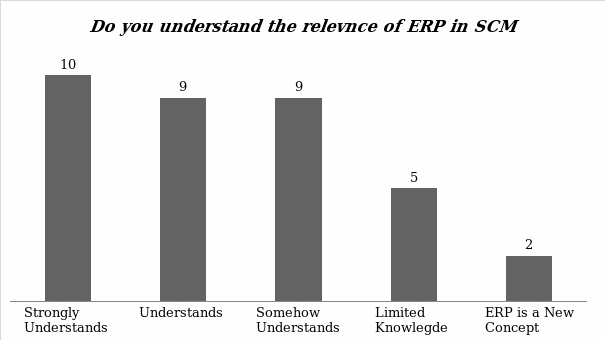
Do you believe there is goodwill among the management in supporting the use of ERP in SCM at your firm?
Implementation of enterprise resource planning is often affected by the inability or unwillingness of the management to embrace the concept. According to Erlingsson and Brysiewicz (2017), the initial cost of implementing ERP is often high as new equipment will have to be purchased and stalled, and employees trained on how to use it. Some heads of departments may also be uncomfortable with the idea of having a platform where their departmental information will be readily available to other departments in real-time even before they are refined. As such, they may try to frustrate its implementation by limiting resources available or directly opposing attempts to introduce it. When the management fails to support the implementation of ERP, it may not be easy to implement it. They are responsible for policymaking and the release of resources needed to introduce the system. As such, the researcher wanted to determine if, indeed, the management of this organization has the goodwill to support its introduction.
The overwhelming majority of the participants (29 out of the 35 interviewed) agreed with the statement that the management unit of the organization has goodwill towards enterprise resource planning. They stated that those in leadership positions at the firm had given their commitment to support it. Three participants were not sure about this issue, explaining that they have not been in this company long enough to explain the level of commitment of the management towards this concept. Another three participants did not provide any response to this question, stating that they would not be willing to comment on issues relating to the management of the firm for personal reasons. It is necessary to note that none of the participants disagreed with the statement that the management of this firm has goodwill towards ERP. As such, the researcher concluded that the leadership of this firm is committed to the implementation of ERP in supply chain management.
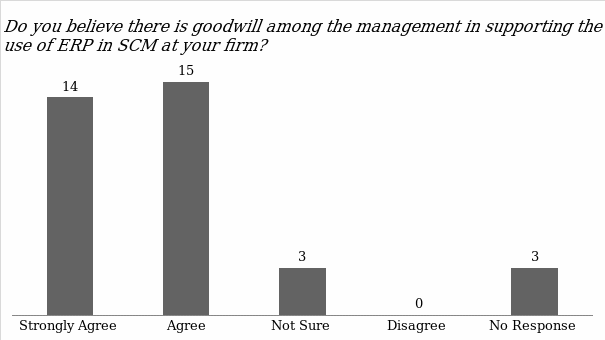
Do you believe stakeholders in this company understand the relevance of ERP in enhancing the effectiveness of SCM?
The management may support the implementation of ERP in SCM within a given organization, but their effort may be thwarted if most of the stakeholders lack an understanding of the new concept and its relevance. In an organization that has a board of directors, the top managers must ensure that they have the support of the board before making a major investment decision or introducing a new system, which might have a major impact on the normal operations of the firm. Costa, Ferreira, Bento, and Aparicio (2016) believe that people tend to support a new concept if they understand its benefits and the manner in which it will benefit the entire firm. Junior employees, who will take part in the implementation of the concept, should also understand what ERP is and how it can be used to enhance their activities at the firm.
A significant majority (26 out of the 35 interviewed) agreed with the fact that stakeholders at this firm understand the concept of enterprise resource planning and its relevance in supply chain management. The branch manager explained that the concept is not new in the firm, and it has been discussed extensively at different levels of management in the past. Eight participants stated that they are not sure whether stakeholders at the firm understand the concept. One of them stated that the concept might be clear to those in managerial positions but not to all the stakeholders. Another explained that many people might understand the concept of enterprise resource planning but have limited knowledge about how it can be applied in enterprise resource planning. One participant disagreed with the rest, stating that understanding enterprise resource management is one thing and knowing how it should be used in supply chain management is another. Although there were conflicting views over the issue, statistics show that the majority believe stakeholders of this company understand how enterprise resource planning can be used in supply chain management to improve productivity. Such an understanding is needed to promote the new concept. Figure 3 below shows the statistical outcome of the analysis of the responses given by participants:
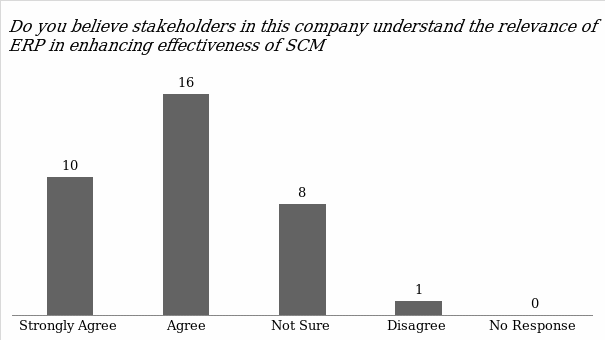
Do you believe employees at your organization have the right skills needed in the implementation of ERP?
The implementation of enterprise resource planning in an organization requires a team of highly skilled workers who understand how they can operate in such an integrated environment. According to Shen, Chen, and Wang (2016), it is always more advisable to train the current employees than to recruit new ones when introducing a new concept and technology in an organization. They have the capacity to understand how to integrate the new technology within the firm in the best way possible. As such, their skills in this field and the capacity to help in the implementation of enterprise resource planning are critical. Gavidia (2017) explains that a firm can only succeed in introducing a new concept if its employees have the needed skills. For instance, workers in the production department need to understand how they need to update the consumption of raw materials so that the procurement unit will understand when it is necessary to organize for a new purchase. The procurement department will also need to know how to use the new system to communicate with the finance department so that the needed resources can be released.
The respondents were asked whether they believe employees at their organization have the needed skills that can enable them to be part of the implementation of the enterprise resource planning (Gavidia, 2017). As shown in figure 4 below, an overwhelming majority of respondents (31 out of the 35 interviewed) believe that employees of this firm have adequate skills necessary for the implementation of ERP. The branch manager explained that ERP as a concept had been discussed within the firm for a long period, especially among employees who are expected to be actively involved in its implementation. The assistant manager and the majority of the other respondents confirmed the statement. As such, it is not a new concept that would be challenging to implement. Three participants explained that they have not interacted with most of the employees, and as such, could not be sure whether they have the needed skills for ERP implementation. One participant disagreed with the rest, stating that the firm still lacks skilled employees who can engage in the implementation of ERP in supply chain management. This particular participant argued that the relevant skills could only be gained through practice. However, most of these employees lack experience in using the new technology, and that they only rely on information gained through regular seminars conducted in the firm. This argument was refuted by the supervisors and those in the management unit who said that the firm has invested a lot in equipping employees with relevant skills and that their capacity to use the new technology has already been put to the test.
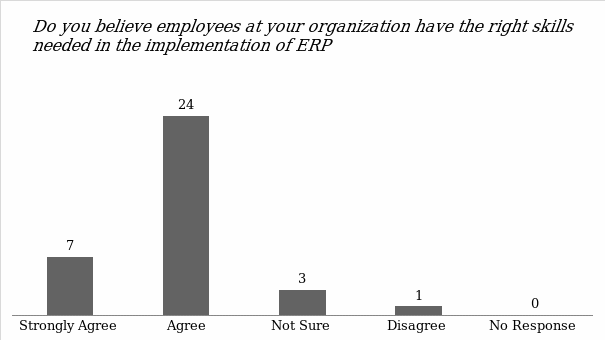
Do you agree with the argument that enterprise resource planning improves interdepartmental communication and coordination?
The question focused on determining the capacity of enterprise resource planning to improve interdepartmental communication and coordination. When reviewing the literature, the findings revealed that one of the main benefits of ERP is that it improves interdepartmental communication and coordination. Gavidia (2017) explains that this technology creates a system where the firm has a central database where all departments can share information in real-time. In the past, the head of one department had to contact a colleague in another department and request the needed data. Such lengthy processes often lead to time wastage and limited coordination of activities within a firm. ERP ensures that workers can have access to information they need to undertake a given responsibility without having to go through lengthy processes (Nwankpa & Roumani, 2014). It also ensures that the head of the department can have access to data as soon as it is processed. It was necessary to determine if those who were participating in the study shared similar views.
As shown in figure 5 below, the majority of the respondents (33 out of the possible 35) stated that indeed enterprise resource planning improves interdepartmental communication and coordination. One of the supervisors interviewed explained that when the new system is implemented, it eliminates unnecessary movement of workers, which would otherwise lead to time wastage. Instead, it makes it possible for workers to get the information they need from the central database. It also makes one department get data from another department without seeking numerous and unnecessary permissions.
The fact that everyone knows that activities are under surveillance by other members of the organization creates a sense of responsibility and commitment, which in turn improves the overall performance of the organization. When using ERP, the branch manager noted that it becomes possible to coordinate activities of different departments. The manager can easily trace problems from their original source and identify specific individuals who should be held responsible. It also makes it easy to find ways of addressing issues before they can escalate. For instance, when there is an accounting error, it is easy to identify its source within the shortest period possible and find ways of addressing it in an effective manner. Two participants stated that they have limited experience on issues relating to enterprise resource planning, and as such, they were not sure about the ability of ERP to improve interdepartmental communication and coordination. None of the respondents stated that enterprise resource planning does not improve communication and coordination.
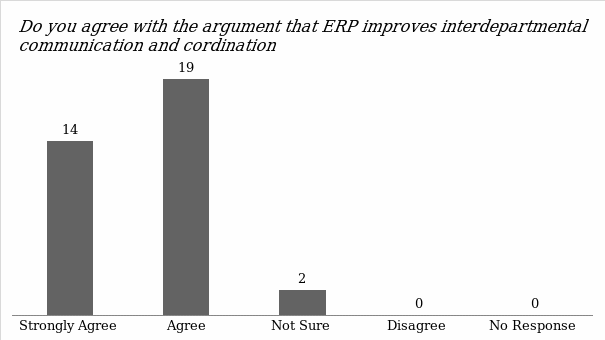
Do you believe that enterprise resource planning can help your organization to cut unnecessary costs and reduce wastage?
The review of the literature revealed that one of the main benefits of enterprise resource planning in any organization is the cutting of operational costs and reducing unnecessary wastage. According to Shen et al. (2016), the new system creates a platform where the procurement department can understand when to order raw materials depending on the rate of consumption and the amount available in reserve. In such a system, cases, where excess raw materials are ordered would be eliminated. One of the factors that often lead to wastage and an overall increase in the cost of operation is ordering more than needed products. It creates a situation where the materials perish before they can be used for the actual process of production. The cost is also increased when excess order is made because of the need to handle the materials more often than would be necessary. ERP creates a platform where planning is easy for everyone involved. The team would end up ordering what is only needed to avoid wastage.
The researcher was interested in determining whether participants shared similar views. As shown in figure 6 below, the majority of the respondents (32 out of the 35 interviewed) felt that ERP could help lower the cost of operations and reduce wastage in a firm. One of the assistant managers explained that the increased surveillance made possible through ERP discourages cases of pilferage within the firm. Employees are aware that there is a digital trail of information on how they spend resources assigned to them. The system makes it easy for those in authority to know if resources have been misappropriated and those who could be responsible for such acts. One of the supervisors noted that such a system eliminates time wastage within an organization. The time that would be taken seeking documents from one department is spent on other activities. When tasks are completed within a short period, it cuts the overall cost of operation, as one of the respondents noted. The branch manager noted that the close coordination of different departments eliminates cases where projects are delayed because of poor communication among those responsible for different tasks. The firm ends up spending less on such projects because of the effective coordination of different units. Two participants noted that they are not sure about the effectiveness of enterprise resource planning in cutting unnecessary costs and reducing wastage within a firm.
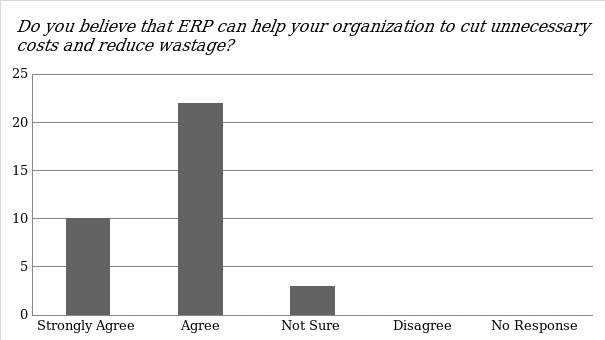
Do you believe your organization is fully prepared to automate its supply chain management using enterprise resource planning?
When planning to automate supply chain management, it is important for a firm to have a clear plan on how to undertake various activities. It should also be clear who would be responsible for which activity to enhance the success of the whole process. Shen et al. (2016) explains that the level of preparedness is often defined by having a team of workers who have the capacity to undertake specific duties and resources needed to make the whole process a success. Many firms often fail in their attempt to introduce new systems of operation because of poor planning. According to Gavidia (2017), when supply chain management goes beyond the procurement of the needed resources and when planning to automate the system, all the relevant stakeholders should be involved. It starts with the sales and marketing team that needs to communicate with the production department about the number of products needed within a specific period. The production unit should pass information about the resources needed for the production process. The finance department will need to be noted to make available money for the purchase of the raw materials. The transport unit should ensure that the materials are delivered to the firm’s premises, while the warehousing unit will be responsible for the safe storage of the products (Nwankpa & Roumani, 2014). These departments should be fully prepared for the introduction of an automated system.
The respondents were asked to share their views about the level of preparedness of the firm to automate its supply chain management using enterprise resource planning. A significant majority of the respondents (23 out of 35 participants) stated that they believe the firm is fully prepared to embrace the new system. The majority of the supervisors explained that workers of this firm had been trained to use the system, and they cannot find it challenging to operate under the new system. The branch manager explained that the system had been tried and tested at other branches of this company, and it was a success because of the level of preparedness of the firm. As such, this branch has received the relevant resources to enable it to address any other concerns that may affect the program’s rollout. Heads of all the departments have been informed about the possibility of automating the supply chain management using enterprise resource planning, and they are all positive about it.
They feel that it will address challenges faced in the previous system, especially when it came to sharing of data. These heads of departments have also promised to prepare employees and systems within their area of jurisdiction to ensure that the process would run smoothly. It is necessary to note that a significant number of participants (9 out of 35) stated that they are not sure about the level of preparedness of the firm to introduce enterprise resource planning in its supply chain management. They argued that the management unit has the capacity to provide such an explanation. Two participants strongly disagreed with the argument that the organization is fully prepared to automate its SCM using ERP. The two explained that the top management is yet to engage all the employees to ensure that they understand the new concept. As such, a section of the workforce still feels uncomfortable with the new system and fear that it may have negative consequences that the management is not willing to inform them at the moment. One respondent failed to respond to the question because of personal reasons. Figure 7 below summarizes the information obtained from the respondents over the issue.
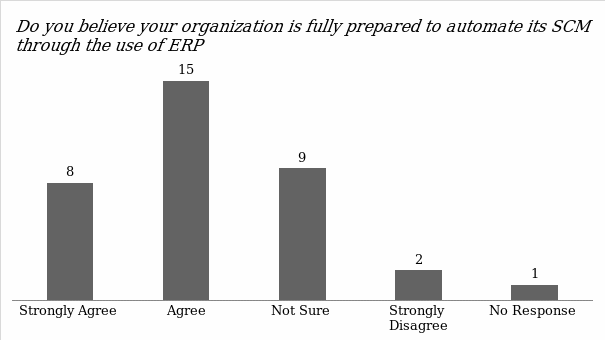
Is there a direct relationship between your current firm’s performance and its implementation of enterprise resource planning (or lack of it)?
One of the important issues that the researcher was concerned about was the determination of whether the implementation of enterprise resource planning has a direct positive impact on the organization, as suggested in the review of the literature. According to Erlingsson and Brysiewicz (2017), although the process may be costly, many firms that have implemented the system have recorded improved performance. One of the main benefits of this system is that it enhances the coordination of different departments and employees who are conducting different activities focused on achieving the same outcome.
Through the system, one team can know what their colleagues in another department are doing, making it possible for them to work as a team with the aim of achieving similar goals. Tarhini, Ammar, Tarhini, and Masa’deh (2015) conducted a study on several companies in the United Kingdom and other European nations that have embraced the new system. The study revealed that enterprise resource planning promotes commitment and determination among individual employees. They know that their output can easily be measured within a specific period. As such, they tend to put in additional effort to avoid any punitive measures that the firm may have towards underperformers. The extra effort of every individual employee has an overall positive impact on the performance of the firm. It was necessary to determine whether participants shared a similar view based on their experience at this firm.
As explained above, this specific branch has been preparing to implement enterprise resource planning in its supply chain management, but the official launch was yet to be made by the time data was collected from participants. However, several other branches have implemented the system, and most of the employees at this branch are aware of the outcome of the process. As shown in figure 8 below, the majority of the respondents (28 out of 35 participants) felt that the implementation of the system at other branches had improved the level of performance of the firm. The branch manager noted that some of the branches whose performance was less satisfactory had improved significantly following the implementation of the new system. One of the assistant managers explained that the performance of this branch is currently considered less satisfactory because it is yet to introduce the new system. One of the supervisors explained that the time when a firm had to rely on traditional methods of managing data, especially the use of physical files, is long gone. Embracing the emerging technology of managing information has a direct impact on the performance of the firm. Two participants explained that they have limited information about the ability of the new system to improve a firm’s performance because it is yet to be introduced at this branch. As such, they stated that they were not sure about the exact impact of ERP on the firm’s performance. Five other participants did not provide a response to the question because of personal reasons.
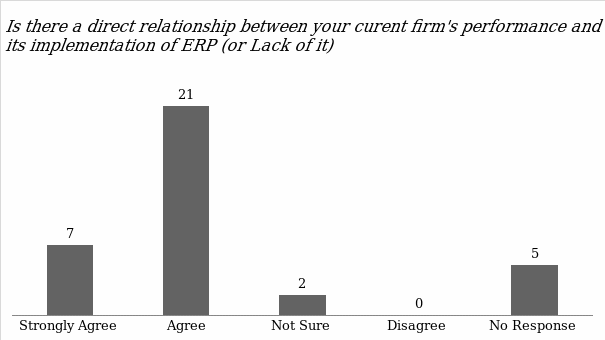
Do you believe the long-term benefits of ERP are worth the investment that your company has made to install the system and train its employees?
The question focused on determining whether it is worth spending resources on enterprise resource planning. Information obtained from the review of the literature indicated that implementing enterprise resource planning has long-term benefits, but it also requires a significant amount of investment. First, an organization has to invest in purchasing the necessary equipment needed for the management of data in an integrated form. Secondly, it is necessary to train the workforce so that they can understand what is expected of them under the new system (Nwankpa & Roumani, 2014). In many cases, on-job training would be needed to ensure that workers gain practical skills on how to undertake their duties under a new system. Hiring trainers on a regular basis may cost a firm a significant amount of money. However, such expenses would be justified if the outcome of the process has long-term financial benefits.
The researcher engaged the respondents to determine their view on the relationship between the long-term benefits of ERP against the cost of its implementation. As explained before, this company has been introducing enterprise resource planning in different branches just to ensure that it does not spend a lot on a project that may have hidden consequences. In the branch where the interview was conducted, preparations are already underway to introduce the new concept. However, the employees have information about the outcome of the system in other branches, hence had the capacity to answer the question. As shown in figure 9 below, the majority of the participants (29 out of the 35 participants interviewed) believe that the long-term benefits of enterprise resource planning are worth the investment their firm has made. The branch manager explained that the level of improved coordination that other branches are enjoying following the introduction of ERP is an indication that it is worth investing in this project. One of the supervisors complained that the traditional system makes it difficult to share data among different departments. An officer would sometimes be forced to wait for a piece of information from another department for a long time, slowing activities within the firm. Two respondents stated that they are not sure about the actual issue because they do not know the actual cost of implementing the system. Four participants did not respond to the question.
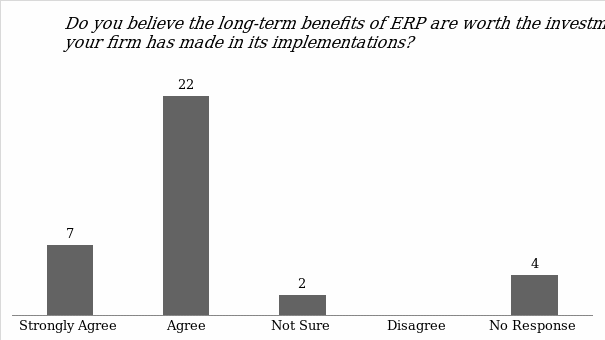
What are the main challenges that you have noticed when implementing ERP in SCM?
After identifying the benefits of enterprise resource planning in supply chain management, the researcher was also interested in identifying specific challenges that the firm has to deal with when it makes the decision to introduce the system. During the review of the literature, the high cost of implementing such a system was identified as one of the main issues that a firm has to address. The time and resources that a firm has to spend to train the current employees to equip them with the skills needed to operate under the new system was another concern (Nwankpa & Roumani, 2014). In some cases, a firm has to recruit new employees to help it deal with some of the challenges that may emerge during the process of introducing the new system. It was necessary to determine the views of the participants over the issue.
The branch manager said, “Downtimes due to network failure.”
The branch manager noted that enterprise resource planning software slows down the internet speed and sometimes causes unnecessary downtimes, which slow other activities within the firm. When it was introduced at one of the branches of this company, employees complained that they could not access data at the same speed as before, and cases of downtime were becoming common. It forced the management to upgrade the internet system to ensure that ERP could be run effectively at this firm.
Supervisor 7 said, “When the system goes off from head-office.”
One of the supervisors at this company noted that one of the main concerns is when the system goes off from the head office. In such a case, operations would be paralyzed, and that might affect the productivity of the firm. Employees in other branches would have to wait for the issue to be resolved at the head office before resuming operations.
How does your organization address challenges that it faces when implementing this system in SCM?
The researcher was interested in determining how the firm dealt with the challenges identified. Given that the company had introduced the system and some challenges were identified, it was necessary to discuss ways in which they were addressed. Gavidia (2017) explains that each problem within an organization needs to be dealt with individually, based on its nature and various other internal and external factors. The respondents identified different ways in which the firm dealt with the challenges.
The branch manager said, “The branch had to shift to an alternative server at head office.”
According to the branch manager, the issue of downtimes caused by network failure was solved by shifting to an alternative server at the head office. The operations had to continue, and as such, the immediate solution was to use an alternative server as the technical team searched for a lasting solution.
Assistant Manager 1 said, “First inform the customer about the issue (no written policy).”
The manager noted that the company is yet to have a standard way of responding to challenges associated with the implementation of enterprise resource planning. However, one of the first steps that should be taken, according to this manager, is to inform clients about the issue. They should know about the problem and the possible effect that it may have on the timely delivery of products.
Supervisor 8 said, “We contact the IT people.”
One of the supervisors explained that when such issues arise, the only solution is to call the IT experts to find reasons why the internet develops problems when ERP is introduced. The supervisor further explained that the experts believe the internet speed and capacity need to be upgraded upon the introduction of the system.
Conclusion and Recommendations
Introduction
The previous chapter provided a detailed analysis of data collected from primary sources. The analysis made it possible to answer the research questions that were set when developing a research proposal. In this final chapter, the researcher provides a summary of the findings made in the study, a conclusion, recommendations, and suggestions for future research. It explains if the objectives of the study were realized and specific issues relating to this topic that still needs to be investigated through future studies.
Summary of the Study
Enterprise resource planning is an effective method of automating the supply chain management of an organization. The ability of a firm to achieve success in the market is significantly influenced by the nature of its supply chain management. From the moment raw materials are availed in the firm to the processing stage, warehousing, and when it is taken to the market, effectiveness, and efficiency should not be compromised. Wastage of raw materials at different stages often leads to inflation in the cost of production, forcing a firm to adjust the market price. It also lowers profit margins in cases where an increase in price may have serious consequences on the sale of a firm’s products. Enterprise resource planning helps in dealing with such challenges. As shown in data analyzed from both primary and secondary sources, enterprise resource planning has the potential to transform the operations of a firm positively if it is implemented in an effective way. It helps to integrate various departments through a communication system that is centralized. Coordination of activities becomes simple because of the easy flow of information from one team to another.
Conclusions
The study has revealed that enterprise resource planning is effective in improving the performance of an organization. It helps to integrate different activities related to the supply chain management of an organization. When ERP is introduced, it makes it possible for the sales and marketing unit to communicate with the production unit in a timely manner to ensure that the needed products are availed at various outlets. It eliminates cases where excess products are delivered in the market, which would result in wastage. It also ensures that the right amount of raw materials is delivered to the production unit to reduce the cost of warehousing and eliminate wastage. In such an efficient supply chain management, a firm is capable of lowering the overall cost of production. It allows it to charge competitive prices while at the same time make attractive profits. The primary data showed that when an organization is planning to introduce this new system, it should be ready to deal with various challenges. The high initial cost of introducing the system was identified as one of the main issues that may hamper the implementation process. Slow internet speed, the need to train workers, and reduced departmental privacy were the other concerns raised.
Recommendations
An organization should be ready to deal with any challenges that might arise when implementing enterprise resource planning as a way of automating supply chain management. The study identified various issues that may affect the smooth implementation of the system. The following are the recommendations that a firm should consider to improve efficiency when introducing the system:
- The company should ensure that all stakeholders are informed and properly prepared for the new system before its official launch.
- The management should upgrade the internet system before introducing enterprise resource planning to avoid the issue of downtimes.
- The firm should take its employees through proper training on how to work under the new system to enhance efficiency.
- The management should assemble a team of IT experts who can deal with various technical problems that may arise in the system.
Suggestions for Further Research
Enterprise resource planning is a relatively new concept that is gaining popularity rapidly in the country. The findings of this study reveal that it is the best way of automating supply chain management within an organization. However, it was of great concern that customizing the ERP to meet a specific organization’s needs may not be possible. Future research should focus on how ERP can be customized to meet an individual firm’s needs.
References
Bell, E., Bryman, A., & Harley, B. (2018). Business Research Methods. Oxford, UK: Oxford University Press.
Costa, C.J., Ferreira, E., Bento, F., & Aparicio, M. (2016). Enterprise resource planning adoption and satisfaction determinants. Computers in Human Behavior, 63(1), 659-671.
Erlingsson, C., & Brysiewicz, P. (2017). A hands-on guide to doing content analysis. African Journal of Emergency Medicine, 7(3), 93-99.
Gavidia, J.V. (2017). A model for enterprise resource planning in emergency humanitarian logistics. Journal of Humanitarian Logistics and Supply Chain Management, 7(3), 246-265.
Nwankpa, J., & Roumani, Y. (2014). Understanding the link between organizational learning capability and ERP system usage: An empirical examination. Computers in Human Behavior, 33, 224-234.
Shen, Y.C., Chen, P.S., & Wang, C. H. (2016). A study of enterprise resource planning (ERP) system performance measurement using the quantitative balanced scorecard approach. Computers in Industry, 75(1), 127-139.
Tarhini, A., Ammar, H., Tarhini, T., & Masa’deh, R. (2015). Analysis of the critical success factors for enterprise resource planning implementation from stakeholders’ perspective: A systematic review. International Business Research, 8(4), 25-40.
